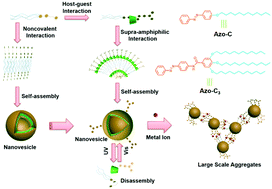Controllable and large-scale supramolecular vesicle aggregation: orthogonal light-responsive host–guest and metal–ligand interactions†
Abstract
On the basis of the host–guest molecular recognition interaction between β-cyclodextrin and azobenzene, two kinds of supramolecular self-assemblies (Py-CD⊃Azo-C and Py-CD⊃Azo-C3) were constructed. Owing to the azo group on the guest molecule, supramolecular vesicles could reversibly realize disassembly and reassembly under irradiation with UV and visible light. Because of the existence of terpyridine groups on the surfaces of supramolecular vesicles, addition of metal ions triggers the vesicle–vesicle self-assembly from the nanoscale to the microscale.



 Please wait while we load your content...
Please wait while we load your content...